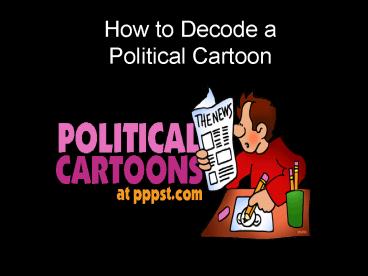How to Decode a Political Cartoon - PowerPoint PPT Presentation
1 / 18
Title:
How to Decode a Political Cartoon
Description:
Tools Used By Cartoonist Exaggeration Allusion Analogy Symbolism Caricature Stereotype Humor Personification CARICATURE Exaggerates one or more features of a person ... – PowerPoint PPT presentation
Number of Views:94
Avg rating:3.0/5.0
Title: How to Decode a Political Cartoon
1
How to Decode a Political Cartoon
2
Definitions
- "political" that which is concerned with public
affairs or government - "cartoon" a sketch or drawing that interests or
amuses by portraying persons, things, political
events or situations etc. in an exaggerated way
3
Definitions
- SATIRE - uses humor to lower something or someone
in the readers or viewers estimation. It is not
mean-spirited and its point is not to harm. It
exposes human folly to make room for improvement.
4
What are Political Cartoons?
- Political cartoons usually appear on the
editorial page of your daily newspaper. They
generally deal with events or issues currently in
the news and are, in essence, visual editorials.
Like the writer of an editorial, the cartoonist
is trying to make a point.
5
What are Political Cartoons?
- When you look at a political cartoon produced
many years ago you are seeing it out of its
original context. In order to "get it" you will
likely need some background information from
classroom discussion, a textbook or your own
research. Once you have a general idea of the
topic at hand you can start to decode the message
the cartoonist is trying to convey.
6
Tools Used By Cartoonist
- Exaggeration
- Allusion
- Analogy
- Symbolism
- Caricature
- Stereotype
- Humor
- Personification
7
CARICATURE
- Exaggerates one or more features of a person or
thing. It attempts to say something about the
person/things character, beliefs, actions or
significance. - Makes them easily recognizable.
8
SYMBOL
- Represents something else. It is a often a
material object that represents something
abstract or invisible (for example, the Statue of
Liberty to represent freedom or the stars of the
confederate flag as KKK).
9
METAPHOR
- Uses an object to note a similarity to something
else. For example,
10
IRONY
- Expresses an idea through a contradiction between
somethings literal meaning and the intended
meaning. For example, picturing a U.S. president
with a crown on his head. - SARCASM- is a form of irony. The element that
turns irony into sarcasm is the appearance of
mockery, or bitterness.
11
(No Transcript)
12
STEREOTYPES
- Works by taking a real or imagined trait of an
individual to be true of the group to which the
individual belongs. They express bias and can be
unfair and harmful. The black man is sketched to
look like an ape, with large lips and no shoes.
13
Analogy Allusions
- Another very important technique is the use of
analogy, in which one event is represented by
another. - An allusion is understandable only to those with
prior knowledge of the reference in question
(which the writer assumes to be so). - A one-sentence or one-phrase (or image) reference
to another event, character, etc. in the Bible,
mythology, or current event
14
Three kings follow star to Barack Obama, savior
of the Democrats.
15
Personification
- Depiciting an inanimate object or abstraction
with human qualities or abilities.
16
Biases
- When you look at a political cartoon you should
consider the biases of the cartoonist. The
cartoonist, after all, is trying to make a point.
When and where was the cartoon published, and in
what type of publication? Who is portrayed in a
favourable manner and who is not? - Cartoons can display a number of other biases as
well (such as political, religious, racial or
ethnic, vocational, economic or gender biases).
17
(No Transcript)
18
Decode the message by using the following method
- Background Knowledge
- Issue
- Devices
- Caricature
- Analogy
- Words
- Signs, symbols, stereotypes, size shading
- Biases of the cartoonist
- Interpretation






























